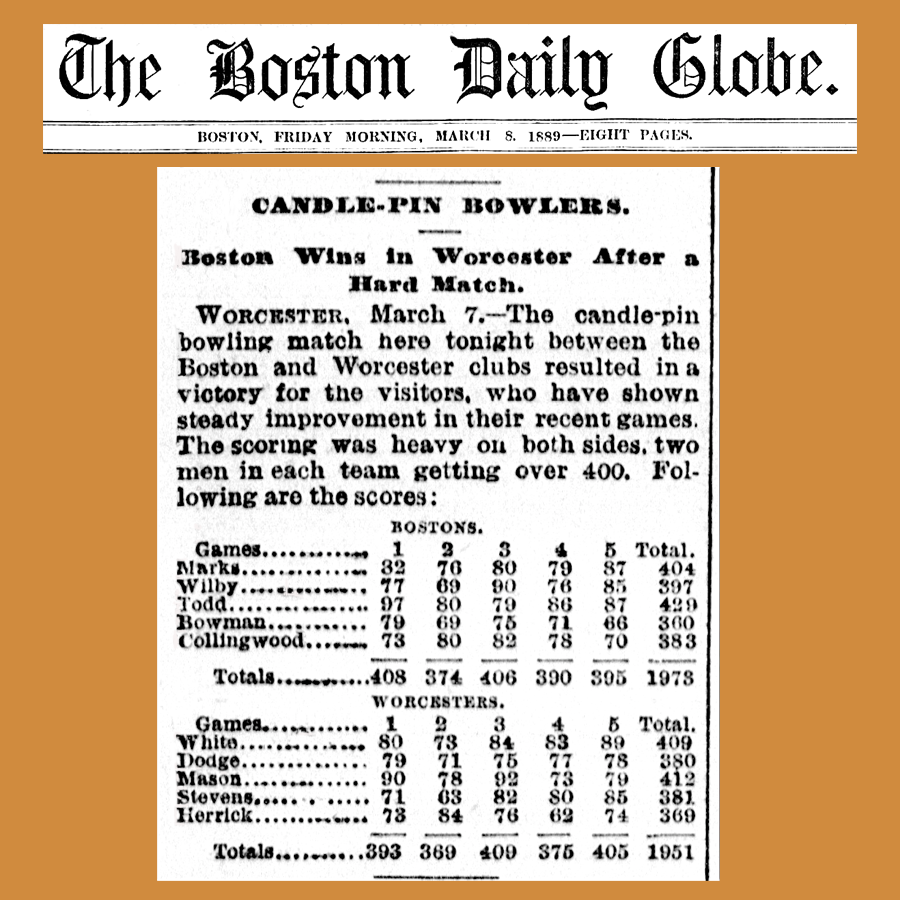|
Bowling For Dollars
''Bowling for Dollars'' is a television game show on which people could play the sport obowling to win cashand sometimes prizes based on how well they bowled. Unlike most TV game shows of the time, which were taped in either New York or Hollywood and broadcast nationally, ''Bowling for Dollars'' was produced by local TV stations and featured contestants from the immediate area. The show was actually a franchise, created by Bert Claster of Claster Television, also the creator of ''Romper Room''. Episodes of ''Bowling for Dollars'' were taped either in a local bowling alley or on a pair of bowling lanes constructed right inside the TV studio. The show reached its heyday in the 1970s. The most recent station to air the format was Detroit, Michigan independent station WADL, which relaunched ''Bowling for Dollars'' in September 2013. The show The show's main set consisted of a sliding door from which the host emerged, as did the contestants, one by one. There was also a Jackpot li ... [...More Info...] [...Related Items...] OR: [Wikipedia] [Google] [Baidu] |
Game Show
A game show is a genre of broadcast viewing entertainment (radio, television, internet, stage or other) where contestants compete for a reward. These programs can either be participatory or Let's Play, demonstrative and are typically directed by a game show host, host, sharing the rules of the program as well as commentating and narrating where necessary. The history of game shows dates back to the invention of television as a medium. On most game shows, contestants either have to answer questions or solve puzzles, typically to win either money or prizes. Game shows often reward players with prizes such as cash, trips and goods and services provided by the show's sponsor. History 1930s–1950s Game shows began to appear on radio and television in the late 1930s. The first television game show, ''Spelling Bee (game show), Spelling Bee'', as well as the first radio game show, ''Information Please'', were both broadcast in 1938; the first major success in the game show genre was ... [...More Info...] [...Related Items...] OR: [Wikipedia] [Google] [Baidu] |
Bowling For Soup
Bowling for Soup (abbreviated as BFS) is an American rock band formed in Wichita Falls, Texas, in 1994. The band consists of Jaret Reddick (lead vocals, guitar), Chris Burney (guitar, backing vocals), Gary Wiseman (drums, percussion, backing vocals), and Rob Felicetti (bass, backing vocals, acoustic guitar). The band is best known for its singles "Girl All the Bad Guys Want", " 1985", "Almost" and "High School Never Ends". The band is also known for performing the introduction to the Disney Channel TV show ''Phineas and Ferb'' and the vocal theme for ''Sonic Unleashed''. History Early years Bowling for Soup has its origins in Wichita Falls, Texas, where Jaret Reddick and other members of the band grew up. Reddick and original drummer Lance Morrill met in the fall of 1976, then reconnected in kindergarten in the fall of 1977. Reddick began playing music in 1985, at 13 years old. Reddick and guitarist Chris Burney knew each other in high school (they met in 1986) and as students i ... [...More Info...] [...Related Items...] OR: [Wikipedia] [Google] [Baidu] |
WWOR-TV
WWOR-TV (channel 9) is a television station licensed to Secaucus, New Jersey, United States, serving the New York City area as the Flagship (broadcasting), flagship of MyNetworkTV. It is owned-and-operated station, owned and operated by Fox Television Stations alongside Fox Broadcasting Company, Fox flagship WNYW (channel 5). Both stations share studios at the Fox Television Center on East 67th Street in Manhattan's Lenox Hill neighborhood, while WWOR-TV's transmitter is located at One World Trade Center. History WOR-TV (1949–1987) Early history Channel 9 signed on the air on October 11, 1949, as WOR-TV. It was owned by the Bamberger Broadcasting Service (a division of Macy's, R.H. Macy and Company and named after the Bamberger's department store chain), which also operated WOR (AM), WOR (710 AM) and WOR-FM (98.7 FM, now WEPN-FM). Exactly ten months earlier, Bamberger launched Washington, D.C.'s fourth television station, WOIC (now WUSA (TV), WUSA), also on channel 9. WOR-TV ... [...More Info...] [...Related Items...] OR: [Wikipedia] [Google] [Baidu] |
Bob Gamere
Robert Gamere (born November 1, 1939) is an American former sportscaster. He primarily worked in the Boston area and hosted a local candlepin bowling show during the 1970s named '' Candlepins for Cash''. Career A graduate of the College of the Holy Cross, Gamere started his broadcasting career calling Holy Cross football and basketball games for WTAG. In 1970 he was hired to succeed Jerry Coleman on the New York Yankees broadcast team. He was chosen out of over 500 applicants for the job. His audition tape was of a basketball game, as he had never called a baseball game before. He was criticized for his overuse of the catch phrase "Here it comes, there it goes" to describe a pitch thrown to home plate and batted anywhere. He was replaced after one season by Bill White. Gamere's career then moved to Boston. From 1973 to 1980 he hosted '' Candlepins for Cash'' on WNAC, as well as calling ECAC Hockey with John Carlson. Carlson called the first and third period with Gamere on co ... [...More Info...] [...Related Items...] OR: [Wikipedia] [Google] [Baidu] |
WHDH (TV)
WHDH (channel 7) is an independent television station in Boston, Massachusetts, United States. It is owned by Sunbeam Television alongside Cambridge-licensed CW affiliate WLVI (channel 56). WHDH and WLVI share studios at Bulfinch Place (near Government Center) in downtown Boston; through a channel sharing agreement, the two stations transmit using WHDH's spectrum from the WHDH-TV tower in Newton, Massachusetts.Network Affiliation of WHDH 7 tviv.org/WHDH From 1982 to 1995, WHDH was Boston's affiliate, inheriting the affiliation from its predecessor on channel 7, . On January 2, 1995, WHDH ... [...More Info...] [...Related Items...] OR: [Wikipedia] [Google] [Baidu] |
Candlepin Bowling
Candlepin bowling is a variation of bowling that is played primarily in the Canadian Maritime provinces and the New England region of the United States. It is played with a handheld-sized ball and tall, narrow pins that resemble candles, hence the name. Comparison to ten-pin bowling As in other forms of pin bowling, players roll balls down a 60 foot, wooden or synthetic lane, to knock down as many pins as possible. Differences between candlepin bowling and ten-pin bowling include: # Each player uses three candlepin balls per frame, rather than two. # Candlepin balls are much smaller, being in diameter and weigh 2 lbs. 7 oz, at most. They are almost identical in weight to a pin, as opposed to in ten-pins, where the ball can weigh more than 4 times as much as a pin. # There is no oil applied to the lane, so the ball does not skid, but rolls all the way down the lane. # Candlepin balls lack finger holes. # Candlepins are thinner (hence the name "candlepin") which increases the ... [...More Info...] [...Related Items...] OR: [Wikipedia] [Google] [Baidu] |
Royal Parker
Royal Pollokoff (April 8, 1929 – January 8, 2016), better known by the stage name Royal Parker, was an American television personality. In a broadcasting career spanning the 1940s–1990s, he appeared in various roles, becoming a staple on television screens in the Baltimore, Maryland, area. Early years Born in Baltimore, Maryland, on April 8, 1929, Parker graduated from Baltimore City College in 1946. He began his broadcasting career in the late 1940s on WASA (now WHGM), an AM radio station in Havre de Grace, Maryland, hosting a music program called the ''Royal Record Review''. He moved to television when the medium was in its infancy, joining WAAM-TV (now WJZ-TV) in Baltimore in 1951. Television career Parker served in diverse roles during his more than four decade career in television (1951–1994), including newscasts, sports events, children's programs, announcing duties, and commercials. As a television newscaster with WAAM-TV in Baltimore, Parker covered ... [...More Info...] [...Related Items...] OR: [Wikipedia] [Google] [Baidu] |
Tom Cole (television)
Thomas Jeffery Cole (born April 28, 1949) is the U.S. representative for , serving since 2003. He is a member of the Republican Party and serves as Deputy Minority Whip. The chairman of the National Republican Congressional Committee (NRCC) from 2006 to 2008, he was, during his tenure, the fourth-ranking Republican leader in the House. A member of the Chickasaw Nation, Cole is one of five Native Americans in the House who are enrolled tribal members. The others are fellow Republicans Markwayne Mullin of Oklahoma (Cherokee) and Josh Brecheen of Oklahoma (Choctaw), and Democrats Sharice Davids of Kansas (HoChunk) and Mary Peltola of Alaska (Yupik). In 2022, Cole became the longest-serving Native American in the history of Congress. Early life, education, and academic career Cole was born in Shreveport, Louisiana, the son of John D. Cole and Helen Te Ata (née Gale), who was the first Native American elected to the Oklahoma Senate. They returned to Oklahoma, where family on bot ... [...More Info...] [...Related Items...] OR: [Wikipedia] [Google] [Baidu] |
Chuck Thompson
Charles Lloyd Thompson (June 10, 1921 – March 6, 2005) was an American sportscaster best known for his broadcasts of Major League Baseball's Baltimore Orioles and the National Football League's Baltimore Colts. He was well-recognized for his resonant voice, crisply descriptive style of play-by-play, and signature on-air exclamations "Go to war, Miss Agnes!" and "Ain't the beer cold!" Biography Early life and career Thompson was born in Palmer, Massachusetts, and moved with his family to Reading, Pennsylvania, in 1927. He began his broadcasting career in 1939 at WRAW-AM in Reading, working there until 1942. After spending only a month at WKBN-AM in Youngstown, Ohio, that same year, he joined WIBG-AM in Philadelphia as an on-air announcer. His career was interrupted in October 1943, when he was drafted into the U.S. Army. Promoted to the rank of sergeant, he was sent to Europe aboard the '' Queen Mary'' in January 1945 and fought in the Battle of the Bulge. After an honorabl ... [...More Info...] [...Related Items...] OR: [Wikipedia] [Google] [Baidu] |
Bailey Goss
Bailey may refer to: People and fictional characters * Bailey (surname) * Bailey (given name) Castles and bridges * Bailey (castle), or ward, a courtyard of a castle or fortification, enclosed by a curtain wall * Bailey bridge, a portable prefabricated truss bridge Places * The Bailey, a historic area in the centre of Durham, England * Bailey, Colorado, US, an unincorporated community * Bailey, Minnesota, US, an unincorporated community * Bailey, Mississippi, US, an unincorporated community * Bailey, Missouri, US, an unincorporated community * Bailey, North Carolina, US, a town * Bailey, Oklahoma, US, a ghost town * Bailey, Texas, US, a city * Mount Bailey (other), two mountains in the US and one in Antarctica * Bailey Brook (West Branch French Creek tributary), Pennsylvania, US * Bailey Creek (other) * Bailey Park, Austin, Texas, US * Bailey Peninsula, Wilkes Land, Antarctica ** Bailey Rocks, on the north side of Bailey Peninsula * Bailey Peninsula, Washingt ... [...More Info...] [...Related Items...] OR: [Wikipedia] [Google] [Baidu] |
Duckpin Bowling
Duckpin bowling is a variation of the sport of bowling. Duckpin balls are in (12 cm) to 5 in (12.7 cm) in diameter, weigh 3 lb 6 oz (1.5 kg) to 3 lb 12 oz (1.7 kg) each, and lack finger holes. They are thus significantly smaller than those used in ten-pin bowling but are slightly larger and heavier than those used in candlepin bowling. Duckpins, though arranged in a triangle identical to that used in ten-pin bowling, are shorter, slightly thinner, and lighter than their ten-pin equivalents, which makes it more difficult for the smaller ball to achieve a strike. For this reason, similar to candlepin bowling, the bowler is allowed three rolls per frame. Rules Duckpin bowling has rules similar to ten-pin bowling. In a 10-frame game, bowlers try to knock down pins in the fewest rolls per frame. Bowlers have three balls per frame, instead of two as in ten-pin bowling, to knock over a set of 10 pins. If a bowler knocks down all 10 pins with their firs ... [...More Info...] [...Related Items...] OR: [Wikipedia] [Google] [Baidu] |





